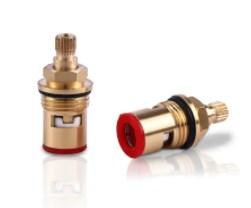Ceramic valve core is an integral component in a variety of fluid control systems, renowned for its precision and reliability. The durability of these components is a critical factor in their widespread adoption across industries. This article delves into the factors contributing to the longevity of ceramic valve cores, their performance under various conditions, and the implications for maintenance and operational efficiency.
The inherent properties of ceramic materials lend themselves well to the construction of valve cores. Ceramic is known for its hardness, chemical inertness, and resistance to wear and corrosion. These characteristics make ceramic valve cores exceptionally durable, and capable of withstanding the rigors of continuous operation in harsh environments. The hardness of ceramic ensures that the valve core maintains its shape and dimensions over time, reducing the risk of leakage and ensuring a tight seal.
Chemical inertness is another key attribute of ceramic valve cores that contributes to their durability. Unlike metal components, ceramic does not react with the fluids it controls, making it an ideal choice for applications involving aggressive or corrosive media. This resistance to chemical attack extends the service life of the valve core, as it is less susceptible to degradation or damage from the substances it encounters.
The wear resistance of ceramic valve cores is a testament to their durability. In applications where the valve is subject to frequent operation, the ceramic material can endure friction and wear that would quickly degrade softer materials. This resistance to wear means that ceramic valve cores can maintain their operational integrity for longer periods without the need for replacement or repair.
Temperature extremes are another challenge that ceramic valve cores are well-equipped to handle. Ceramic materials can operate effectively in a wide range of temperatures, from cryogenic to high-temperature applications. This thermal stability ensures that the valve core remains functional and durable, even in environments where temperature fluctuations are common.
The design of ceramic valve cores also plays a role in their durability. Modern manufacturing techniques allow for the creation of intricate and precise valve cores with tight tolerances. This precision engineering minimizes the potential for leakage and ensures that the valve core performs consistently over time.
However, the durability of ceramic valve cores is not without its limitations. While they are resistant to many forms of wear and corrosion, they can be susceptible to damage from impact or sudden changes in pressure. Proper installation and handling are essential to prevent such damage and maximize the lifespan of the valve core.
Maintenance practices also play a crucial role in the durability of ceramic valve cores. Regular inspection and cleaning can help to identify and address potential issues before they lead to component failure. By keeping the valve core free from debris and ensuring that it operates within its designed parameters, operators can extend its service life and maintain its performance.
In conclusion, the durability of ceramic valve cores is a multifaceted attribute that stems from the material's inherent properties, the precision of its design, and the care taken in its installation and maintenance. By understanding these factors, engineers and operators can make informed decisions about the use of ceramic valve cores in their applications, confident in their ability to provide reliable and long-lasting performance.

